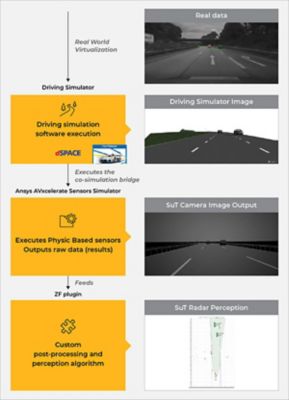Case Study
Ansys empowers the next generation of engineers
Students get free access to world-class simulation software.
Design your future
Connect with Ansys to explore how simulation can power your next breakthrough.
Students get free access to world-class simulation software.
Connect with Ansys to explore how simulation can power your next breakthrough.
Case Study
“The integration of Ansys AVxcelerate into our Virtual Test Drive platform offers a disruptive solution for both hardware (HiL) and virtual hardware (SiL) testing, delivering trustable physics-based camera and radar simulation capabilities. This reduces physical testing for a significant cost-saving advantage, and allows for easy regeneration of synthetic data during sensor selection and placement. We can test systems in complex situations involving multiple vehicles, pedestrians, various objects, and challenging environmental conditions.”
— Lars Schories
Project Lead, Corporate Research and Development/ZF Group
ZF's end-to-end development solution, its Virtual Test Drive tool chain, is defined by numerous simulation tools and solvers running in the background simultaneously to test autonomous driving and advanced driver-assistance systems (AD/ADAS) perception. In introducing Ansys AVxcelerate Sensors (AVx) into this tool chain, along with software from other domains, ZF will create more comprehensive sensor models for perception testing that leads to a deeper understanding of radar and camera in a single simulation environment.
Complexity is the single biggest challenge for ZF in the validation of the self-driving domain defined by sensors. To facilitate the Virtual Test Drive environment required the commingle of multiple physics-based AD/ADAS sensor simulations for radar and camera into one continuous tool chain. During the integration of AVxcelerate Sensors for different autonomous applications within the Virtual Test Drive Toolchain — including dSPACE and IPG Carmaker — any efforts must be adapted and matched to ZF’s current tool chain for AD/ADAS simulation. All aspects of analysis must be considered in this co-simulation environment, as well as the efficacy of the synthetic data produced.
Incorporating AVxcelerate Sensors into its existing tool chain enabled ZF to enhance its Virtual Test Drive tool chain with an accurate, reliable scenario-based approach to virtual sensor testing and validation for radar and camera. The sensor simulation software became part of a well-rounded collection of tools and solvers covering virtual hardware/ software, radar signal, and perception testing. At the end of the complete tool chain, ZF combined the resulting sensor models via IPG CarMaker and AVxcelerate Sensors to demonstrate complete system functions and software integration in a single cloud-based simulation environment. This activity happens within an open-loop system for the immediate future, sequentially adding data from one software to the other.

If you're facing engineering challenges, our team is here to assist. With a wealth of experience and a commitment to innovation, we invite you to reach out to us. Let's collaborate to turn your engineering obstacles into opportunities for growth and success. Contact us today to start the conversation.